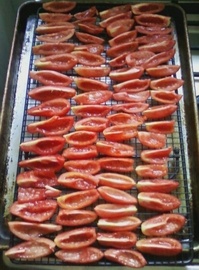The $15,000 solar dehydrator: using your car's heat to sun-dry tomatoes

Jim Leach | Contributor
Our San Marzano tomatoes are ripening in full force now. Their meaty flesh and relatively thin skin make them great for tomato sauce but also for drying. Ah, sun-dried tomatoes. There's nothing like their zesty flavor in mid-winter. To prepare some, I recently fired up my $15,000 solar dehydrator. That might seem like a lot to pay for a solar dehydrator, but mine also gets more than 20 miles to the gallon.
That's right, I use my car as a dehydrator.
I know I've complained about temperature of the interior of the car on a sunny day. It feels hot enough to cook something. I even have one of those solar reflectors to decrease the heat. (We've got another use for those too... as part of a simple but effective solar cooker that we've written about here.) Instead of "wasting" the heat of the car, I put that heat to use to dry tomatoes.

Jim Leach | Contributor
Obviously we can't dry tomatoes in 20 minutes, but we can get our part done and let the sun do the rest. We had had a slight problem on some plants with blossom end rot this year, so maybe a half dozen tomatoes had a speck of black at the tip that was easily cut off. In the interest of accurate reporting, I should say that I was able to do one tray in 20 minutes, but that included picking, washing, preparing and getting the tomatoes into the car. I subsequently readied two more trays, using about 20 tomatoes per rack.

Tomatoes "Before"
Janice Leach | Contributor
The concern is not whether this process will work but whether the tomatoes might end up over-cooked. The goal is not tomato jerky, not to make completely dried out tomato pieces. What we want is something more like a fresh raisin or a fruit roll-up texture-- still pliable, still slightly moist. Home-drying works best with the paste-style tomatoes, like Roma, Amish paste, the long ones shaped like bulbs or torpedoes, which have more "meat" and less liquidy juice to start. The drying time also depends on the weather so drying can take a day or two.
If the day turns gray or a car is not available, sun-dried tomatoes can also be made or finished in the oven. Put prepared tomatoes on racks or cookie sheets into a 150 degree oven. Drying might take 10 to 20 hours. Check the tomatoes periodically and move the racks around as necessary.

Tomatoes after drying
Janice Leach | Contributor
The easiest and healthiest way to store sun-dried tomatoes is in Ziploc bags in the freezer. Fill bags with cooled tomatoes and zip them closed. All this hard work will result in a product about 80 percent lighter than what we started with, but don't be fooled. These little babies pack a lot of punch. Another storage method is to fill a clean jar with tomatoes, top it off with olive oil, and keep in the refrigerator; this, however, is not a low-calorie solution.
I've heard hard-core organic folks muse whether the off-gassing from the PVCs in the car upholstery compromise the purity of the tomatoes, but we haven't worried about that. We enjoy the fruits of our labor long into the winter, tossing sun-dried tomatoes in sauces or on pizza, in soups and scrambled eggs. When all we can get at the grocery are the pale imported tomatoes of winter, we can raid the freezer for bite-sized bits of sunshine in the form of home-grown, home-made, sun-dried tomatoes.
Janice and Jim Leach garden a backyard plot in downtown Ann Arbor and tend the Web site 20 Minute Garden.


Comments
Monica Milla
Fri, Sep 10, 2010 : 6 p.m.
This is the coolest (or hottest!) thing I've read in a long time. Thanks for sharing it. Now I know what to do with my Marzanos!